A Complete Guide to Duotone Kitesurfing Techniques
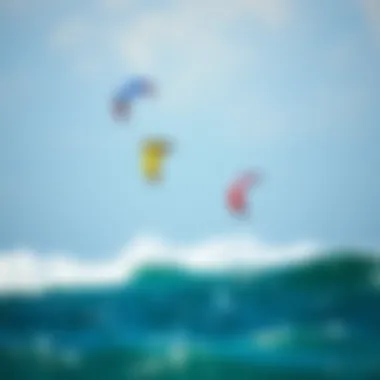
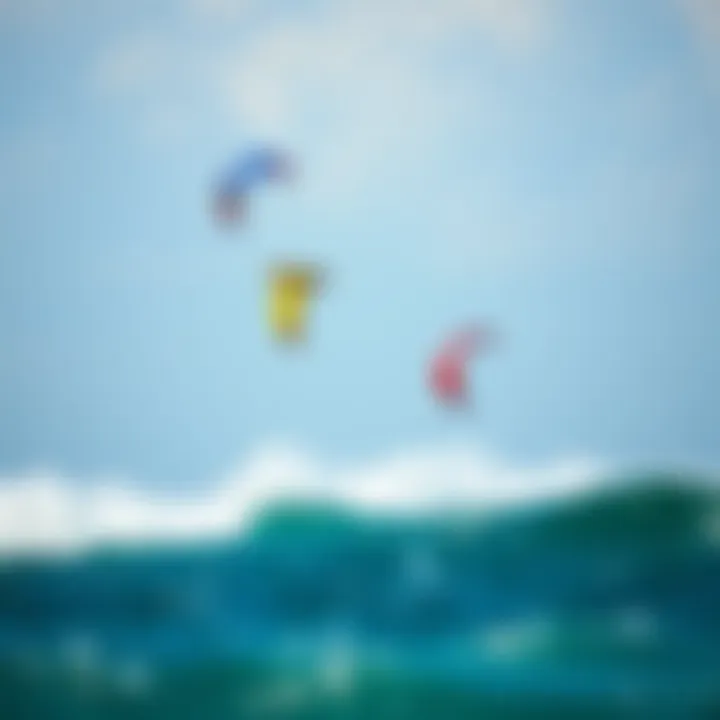
Intro
Kitesurfing is an exhilarating sport that marries the thrill of riding waves with the exhilarating rush of flying a kite. Among the various forms of kitesurfing, duotone kitesurfing stands out, embodying innovation and a keen sense of adventure. This comprehensive guide aims to peel back the layers on duotone kitesurfing, exploring not only its evolution but also diving deep into the practical gear and skills one needs to ride the wind with confidence.
Gear Selection
When it comes to kitesurfing, the right gear is paramount. It’s like a painter choosing his tools; the quality and type of equipment can drastically affect the outcome of your ride. In this segment, we'll examine the essential pieces of equipment that every kitesurfer should consider.
Types of Kites
Duotone specializes in crafting kites that suit a variety of riding styles and conditions. The two main types are:
- Freeride Kites: These are versatile and user-friendly, perfect for beginners and those looking to cruise on the water. Their design allows for easy handling and stability, even in less-than-ideal wind conditions.
- Freestyle Kites: If someone’s aiming to perform tricks and jumps, freestyle kites have a unique shape that enhances lift and provides better responsiveness. Their specific design can give you the edge needed for those bigger air moves you dream of achieving.
Sometimes it’s ideal to have more than one type of kite in your arsenal. Having a variety gives a kitesurfer the flexibility to adapt to changing weather and water conditions.
Choosing the Right Board
Selecting the right board can feel daunting, but it doesn't have to be. Generally, kitesurfing boards can be categorized into three main types:
- Directional Boards: These resemble surfboards and are excellent for riding waves. They have fins which help in carving through the water, making them a favorite among more experienced kitesurfers.
- Twin Tip Boards: Often recommended for beginners, these can be ridden in both directions, which means less hassle when mastering turns. They are typically lighter and offer a more forgiving ride.
- Foil Boards: These have a wing underneath, allowing riders to glide above the water's surface. Foil boards require a bit of skill, but the ease of riding in lighter winds can be rewarding once mastered.
When selecting a board, consider your weight, skill level, and riding style. A misalignment in these areas can lead to frustration on the water.
Skill Development
No matter how high-end your gear is, it won't do you much good unless you can use it effectively. Skill development is crucial in becoming a proficient kitesurfer.
Essential Techniques
Mastering a few core techniques can elevate your kitesurfing experience:
- Body Positioning: Keeping your body aligned with your board ensures better balance and control.
- Edge Control: The ability to dig your board into the water can create speed and stability in various conditions.
- Kite Control: Learning how to fly your kite effectively is key. Spend time practicing with your kite on land to understand its dynamics.
Progression Tips
For those looking to step up their game, consider the following pointers:
- Practice Regularly: The more water time you put in, the better you'll become. Remember, consistency is key.
- Take Lessons: Even experienced riders can benefit from lessons, as professional instructors can help refine your techniques and troubleshoot.
- Set Goals: Whether it's nailing a jump or perfecting a trick, having clear targets can keep you motivated and focused.
For additional resources on kitesurfing locations and environmental practices, consider visiting Wikipedia, or join discussions on platforms like Reddit.
"In kitesurfing, as in life, understanding the winds of change can set you free."
Remember, keeping abreast of current trends is vital for any kiteboarding enthusiast, so make sure to stay updated with the latest in this ever-evolving sport.
Preamble to Duotone Kitesurfing
Kitesurfing is more than just a thrilling water sport; it encapsulates a lifestyle and community. Within this vibrant scene, Duotone Kitesurfing stands out as a prominent brand, known for its innovative designs and commitment to performance. This introduction serves to outline the significance of Duotone in the kitesurfing world, while also touching on its impact on both novices and seasoned riders alike.
Duotone's approach towards kitesurfing focuses on creating gear that marries functionality with style. The kites they manufacture are not merely tools for riding; they are engineered to enhance the experience on the water. Offering a variety of kites, each tailored to differing conditions and riding styles, Duotone appeals to a wide audience. This adaptability is crucial, as kitesurfing conditions can shift dramatically based on the location, time of year, and even time of day.
One of the core reasons Duotone resonates with riders is its commitment to safety and ease of use. Their product range includes features designed to help beginners feel more secure while learning essential skills. As any seasoned kitesurfer will attest, feeling at ease in the water can be the cornerstone for advancing one's technique. Thus, understanding how Duotone tailors its kites for various skill levels lays the groundwork for appreciating their full range of offerings.
Moreover, Duotone's focus on innovation hasn't gone unnoticed. The brand continuously integrates cutting-edge technology into their designs, promoting not only performance but also sustainability—a significant consideration in today's world. With the environment under strain, Duotone is dedicated to crafting products that minimize ecological impact while maximizing fun on the water.
"Kitesurfing is not just a sport; it's a community joined by the love of wind and water."
As we continue through this comprehensive guide, the upcoming sections will dive deeper into the brand's history, the intricacies of their kite designs, and much more, painting a vivid picture for all kiteboarding enthusiasts.
The Evolution of Duotone
The story of Duotone is not just about the kites and boards they produce; it’s about how they have shaped the kitesurfing landscape. Established from the ashes of its predecessor North Kiteboarding, Duotone has brought a fresh perspective to an already thrilling sport. This evolution has been a journey of innovation, aiming to provide riders with cutting-edge gear while emphasizing sustainability and accessibility.
The importance of understanding the evolution of Duotone lies in its commitment to enhancing the kitesurfing experience. Riders looking to elevate their skills need gear that matches their ambition. Duotone has continually reevaluated its design philosophy, focusing on lightweight materials and streamlined profiles for improved performance. By diving deeper into their history, one can appreciate the meticulous research and development that has led to present-day models.
History of the Brand
Duotone’s story begins when the North Kiteboarding brand evolved in 2019 to create a separate identity. This transition wasn’t just a name change; it signified a revolution in approach. The new brand embraced the need for adaptability and innovation. Collaborating closely with riders, designers, and engineers has allowed Duotone to build gear that resonates with the needs and desires of the kitesurfing community.
Key milestones in the history of the brand include:
- The introduction of high-performance kites for different wind conditions, including the Duotone Neo, known for its versatility.
- The development of adaptive boards like the Duotone Whip, aimed at both freestyle and wave riders.
- A strong focus on user feedback to continuously improve product lines.
These factors not only differentiate Duotone from competitors but also solidified its reputation as a forward-thinking brand in the sport.
Significant Innovations
Innovation doesn’t stand still, and neither does Duotone. The company’s pursuit of cutting-edge technology has led to several revolutionary products in the kitesurfing sphere. One of the most notable advancements includes their proprietary materials such as Dacron and the use of lightweight, durable fabrics that enhance durability and performance.
Duotone also introduced the concept of , which synchronizes the kites with boards for a seamless performance experience. This synergy allows for fluid transitions, which is essential for improving a rider’s capabilities. Key innovations include:
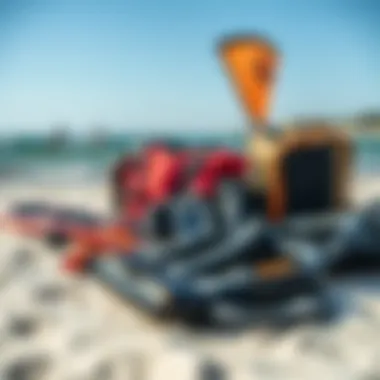
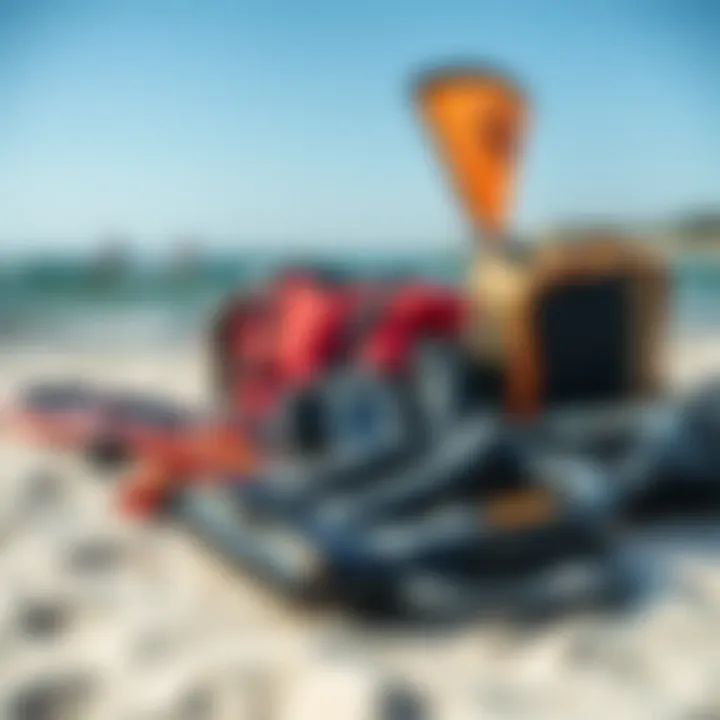
- Easy Handling Systems: Integrated systems that reduce the complexity of setup and launching.
- Advanced Flight Control: New bar systems have made adjustments easier, offering a more responsive and intuitive ride.
- Eco-Conscious Materials: An ongoing commitment to environmental responsibility through sourcing sustainable materials further distinguishes Duotone. This assures riders that their gear not only performs well but is also kinder to the planet.
Through understanding these significant innovations, one can see how Duotone continues to pave the way for not just performance but responsible riding practices as well. The evolution of Duotone represents not just a brand but a movement within the kitesurfing community, as they thrive to inspire and empower every rider.
Understanding Duotone Kites
Grasping the essence of Duotone kites is pivotal for anyone stepping into the thrilling realm of kitesurfing. These kites are not just mere pieces of equipment; they represent a harmonious blend of innovation, design, and personal expression. Knowing what makes these kites tick will enhance a rider's enjoyment and performance on the water.
Kite Design Principles
When talking about kite design, one must consider various factors that play a crucial role in how a kite behaves during flight. These components include shape, size, and material.
- Shape: The shape of the kite affects its lift-to-drag ratio. A deeper profile generally offers more power and stability, while a flatter kite provides speed and agility. Riders must understand their own riding style to choose an ideal shape.
- Material: Kites are typically made from lightweight, durable fabrics, such as ripstop nylon or polyester. These materials reduce the risk of tears and punctures. Selecting a kite made from high-quality materials ensures longevity and reliability, especially when conditions become rough.
- Reinforcement: Strategic placement of reinforcements, particularly at stress points, prevents wear and tear over time. This design principle is invaluable for riders who navigate through challenging terrains or those who engage in more aggressive maneuvers.
Overall, the right kite design principles can mean the difference between an exhilarating ride or a troubling struggle against the wind.
Types of Duotone Kites
Duotone offers a varied range of kites catering to different riding styles and rider competencies. Understanding these types allows enthusiasts to pick the perfect kite suited to their needs.
- All-Terrain Kites: These versatile kites are perfect for riders who want to dabble in different styles, whether it's freestyle, wave riding, or jumping. Their balanced performance ensures a fantastic ride in various conditions.
- Freestyle Kites: If you want to master tricks and aerial stunts, freestyle kites are designed for just that. They typically offer a quick response and excellent lift, allowing riders to pop and execute tricks with greater ease.
- Wave Kites: For those who prefer the ocean's swells, wave kites are the way to go. These are engineered to handle powerful winds while maintaining control and stability. The design helps riders maneuver effectively on the waves, enhancing the surfing experience.
- Lightwind Kites: When conditions are calm, these kites ensure that you have a good time on the water. They are designed to generate lift in lower winds, making them ideal for days when the breeze is light.
"Choosing the right kite type based on your preferred style will significantly enhance your overall kitesurfing adventure."
In summary, understanding Duotone kites—from their design principles to the various types available—equips riders with the knowledge needed to make informed decisions. This knowledge is essential not only for improving performance but also for fostering a deeper appreciation for the sport. Riders who take the time to explore these elements will likely find their time on the water to be more fulfilling and enjoyable.
Selecting the Right Gear
Choosing the right gear for duotone kitesurfing is not just a matter of convenience; it's vital for safety, performance, and enjoyment on the water. Each element of your gear plays a role in how well you can ride, how responsive your kite will be, and ultimately, how much fun you will have. It's a blend of personal preference and practical considerations that dictate the best choices for your specific needs.
Choosing the Appropriate Kite Size
Kite size is arguably one of the most critical elements in kitesurfing gear selection. The size of the kite influences how it interacts with the wind and how you, as the rider, will perform. A larger kite can generate more lift, which is advantageous in lighter winds, while a smaller kite will be more effective in strong winds, allowing for better control and less risk of being overpowered.
When selecting a kite size, consider your weight, skill level, and the typical wind conditions where you plan to ride. Charts provided by manufacturers like Duotone often give guidelines on what sizes are best for certain weight ranges and wind strengths. It’s wise to refer to those charts, but also to remember that personal experience can lead to better suitability than those numbers alone.
Supplementary Equipment
Boards
The board you choose complements the kite and can significantly affect your overall experience. Typically, kitesurfing boards come in different shapes, sizes, and materials. A common choice for many riders is a twin-tip board, which allows for ride versatility and is forgiving for beginners learning to balance and navigate.
A key characteristic of twin-tip boards is their symmetrical design, which enables riders to ride in both directions without needing to switch the board around. This feature is especially handy for those new to the sport or for riders who want to practice tricks and transitions. Furthermore, lighter boards tend to boost performance and agility on the water; however, they may sacrifice some durability in high crash scenarios.
Advantages:
- Versatility in riding style
- Symmetrical for easy directional changes
Disadvantages:
- May require additional effort on choppy waters
Harnesses
Harnesses provide crucial support and comfort, distributing the pull from the kite evenly across your body. There are two main types of harnesses: seat harnesses that sit low on your waist and spread bars across your hips, and waist harnesses that sit higher and allow for more freedom of movement.
A significant characteristic to note is the fit of the harness. A well-fitting harness will keep you secure and minimize chafing and discomfort during your ride. For many riders, waist harnesses are a popular choice because they offer a balance between security and mobility, especially for more dynamic maneuvers. However, if you prioritize comfort while just cruising and relaxing, a seat harness might be preferable.
Advantages:
- Good fit enhances comfort and control
- Better mobility with waist harnesses
Disadvantages:
- Requires precise adjustment for proper fit
Safety Leashes
Safety leashes are essential for keeping you secure while kitesurfing. They attach to both the kite and your harness and provide a means for depower if you find yourself in a tricky situation or you need to release yourself quickly from the kite. As thrilling as kitesurfing can be, safety should always be tops with the use of a good-quality safety leash.
A quality safety leash will often feature a quick-release mechanism, which can be vital in emergencies. Some also come equipped with a coiled design, reducing the risk of tangling in the lines or becoming caught on other objects in the water or on land. Investing in a reliable safety leash can quite literally be a lifesaver on the water.
Advantages:
- Enhances safety and control during rides
- Quick-release for emergencies
Disadvantages:
- Can sometimes snag on equipment if not properly managed
"The right gear is like the right recipe; each ingredient plays a crucial role in cooking up the perfect session on the water."
Techniques for Mastering Duotone Kitesurfing

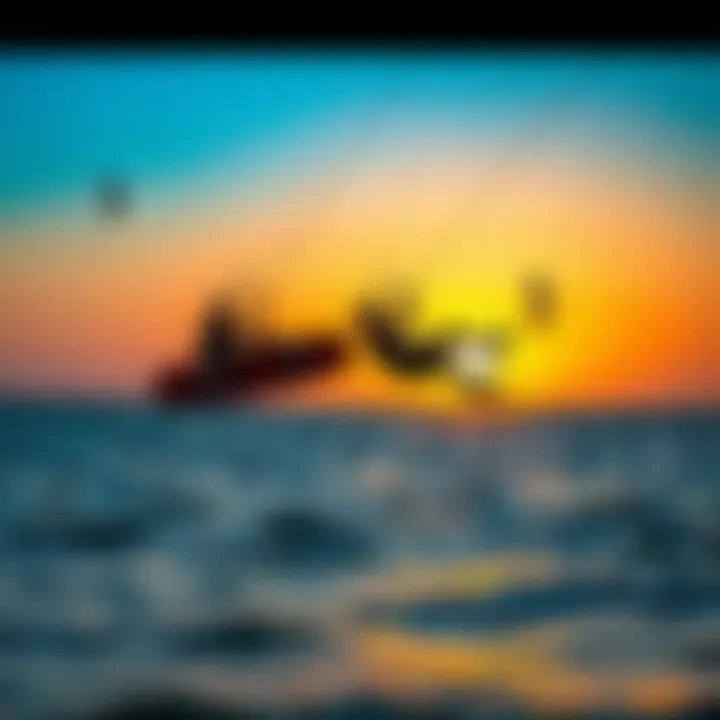
Understanding the techniques involved in duotone kitesurfing is crucial for both novice and experienced riders alike. Mastery of these techniques not only boosts performance but also enhances safety out on the water. This section will delve into the essential skills needed to ride effectively, focusing on both fundamental and advanced maneuvers.
Fundamental Skills
Before you can take to the waves, walking before you run is essential. Fundamental skills form the cornerstone of your kitesurfing experience. Mastering these basics ensures that you can ride confidently and with control.
A good kite control starts with proper grip on the bar. Your hands should remain relaxed, allowing for a smooth maneuvering of the kite. Understand the wind window, which is basically the area where your kite can fly effectively. This knowledge will guide you in adjusting the kite’s position relative to the wind and help maintain a steady flight.
Moreover, body positioning cannot be understated. Keeping your knees slightly bent and your weight centered over your board allows for better stability when riding. Here are some more fundamental skills to practice:
- Launching the Kite: Ensure you know how to launch correctly. A dodgy launch can lead to quick trouble.
- Riding Upwind: Learning to ride against the wind is vital, as it helps you return without needing to turn dramatically.
- Stopping and Turning: These are necessary for both maneuverability and safety. Practice both heel-side and toe-side stops, ensuring you can change direction effectively.
Practicing these skills regularly allows you to build muscle memory and confidence. They will act as your safety net when faced with unexpected conditions.
Advanced Maneuvers
Once you've nailed down the basics, it’s time to elevate your game. Advanced maneuvers add flair to your riding and can distinguish you from the crowd. However, they come with a greater risk and require not just skill but also finesse.
One such maneuver is the jump, where timing and kite position play crucial roles. It’s essential to gently pull on the back hand of the bar while pointing your board downwind to generate lift. Don’t just aim for height; aim for style, control, and, most importantly, a safe descent. Other notable advanced maneuvers include:
- Backrolls and Frontrolls: Both require a good sense of timing and a commitment to rotation.
- Kiteloops: A thrilling move that demands understanding of wind conditions. It involves a strong downwind pull and a quick kite movement.
- S-Bend: A complex aerial move that combines both rotation and inversion, showing advanced control of your body and kite.
"Pushing the boundaries of your riding with advanced maneuvers not only enhances your style but also ignites the passion for kitesurfing."
To execute these maneuvers successfully, consider practicing in less crowded areas first. Have a spotter if possible. Always stay aware of your surroundings and wind conditions. With practice and patience, the impressive skill set you develop will ensure exhilarating experiences on the water, while keeping safety as your top priority.
Safety Protocols in Kitesurfing
Kitesurfing, while thrilling, inherently comes with its own set of risks. Safety protocols form the backbone of a responsible kitesurfing experience. They not only protect individual riders but also ensure the welfare of fellow enthusiasts on the water. With the right safety measures in place, kitesurfers can enjoy the waves without the looming shadow of danger. When one talks about safety protocols, several key factors emerge: equipment checks, understanding wind conditions, and regular training in emergency responsiveness. The bottom line is that preparation and awareness can turn a potentially dangerous sport into a safe and enjoyable one.
Equipment Checks
Before setting foot on the water, performing thorough equipment checks is essential. This process involves assessing every piece of your kitesurfing gear. First, inspect the kite for any visible damage; look for tears or wear on the canopy or the leading edge. A small defect can lead to larger issues when you’re out there, potentially resulting in mid-air losses.
Next, check the lines and bridles—these components are crucial for kite control. A frayed line is like a ticking time bomb; it can snap while you're in the middle of a jump. Take a moment each time to feel the integrity of the bar. Is everything moving smoothly? A stiff bar can interfere with your ability to steer effectively.
After the kite, don’t forget the harness. Make sure that it fits snugly and that the safety mechanism is working perfectly. Additionally, test your safety leash, as this can be your lifeline should anything go wrong. Leaving the beach with untested gear is like diving headfirst into murky waters—you simply don’t know what pitfalls await.
Here are some essential checks to include in your routine:
- Inspect the kite for tears and wear
- Test the lines and bridles for fraying
- Ensure that the harness fits correctly
- Check the safety leash for functionality
By adhering to these simple checks, you bolster your safety and enhance your overall kitesurfing experience.
Understanding Wind Conditions
Another cornerstone of safety in kitesurfing is a solid grasp of wind conditions. Understandably, wind is the primary element propelling the sport; however, it can also become your greatest foe if mismanaged. Learning to read wind patterns and forecasts allows you to make educated decisions before hitting the water.
A steady wind is the ideal condition for kitesurfing. Rapid, erratic changes in wind speeds can create unexpected challenges and potential hazards. Beginners should avoid gusty winds, as they can lead to uncontrolled maneuvers. Even seasoned riders can misjudge the difference between a gentle breeze and a strong gust, so keep your ears open and your eyes peeled when observing local conditions.
It’s useful to familiarize yourself with local spot winds. For example, coastal areas might experience varying wind patterns due to geographical characteristics. Before heading out, check platforms that track real-time data:
- Wunderground for local forecasts
- Windy.com for detailed wind maps
- local forums such as Reddit's kitesurfing for community insights
"Understanding wind conditions isn’t just a technical skill; it’s a rider’s best friend. Knowing when to ride and when to pack up is invaluable for safety and enjoyment."
By honing your ability to gauge wind conditions accurately, you reduce risks that could lead to injury or equipment damage, allowing for a smoother and more enjoyable kitesurfing adventure.
Environmental Considerations
Kitesurfing, while exhilarating, carries a significant footprint on the environments where it thrives. Considering the delicate balance of our ecosystems, the importance of environmental considerations in kitesurfing cannot be overstated. Enthusiasts and professionals alike have a responsibility to navigate these waters with care. By integrating sustainable practices into our kitesurfing routines, we can ensure that the sport continues to flourish for generations to come.
One of the fundamental elements in promoting sustainability is recognizing the interconnectedness of our oceans, beaches, and waterways. Every time a rider hits the waves, there’s a ripple effect. For instance, nearly every piece of gear we use—from the materials in kites themselves to the accessories—has an environmental impact. Introducing eco-friendly alternatives and making conscious choices can mitigate this. It’s crucial for the kitesurfing community to advocate for and adopt practices that not only enhance the sport but also protect the natural beauty we cherish.
"The world is our playground, but it’s also our responsibility to protect it."
Sustainable Practices
When thinking about sustainable practices in kitesurfing, we need to look at several components. Here are some methods that riders can adopt:
- Choose Eco-Friendly Gear: More brands are now producing kitesurfing equipment using sustainable materials. Opting for products made from recycled plastics or organic materials can make a big difference.
- Proper Disposal of Equipment: Instead of discarding old kites and harnesses, consider recycling or donating them. Many organizations accept used gear, extending their life and reducing waste.
- Participate in Clean-Up Initiatives: Many local kitesurfing communities organize beach clean-up events. Active participation not only benefits the environment but also fosters a sense of community and camaraderie among riders.
Minimizing Impact on Ecosystems
In order to minimize impact on ecosystems, awareness of local environments is key. Kitesurfers often find themselves skimming over sensitive habitats. Here are practical steps to take:
- Stay Informed: Before heading out, familiarize yourself with the local flora and fauna. This awareness helps in avoiding fragile areas, protecting habitats for wildlife.
- Respect Wildlife: It's essential to give space to animals, particularly nesting birds or marine life. Respecting no-go areas can significantly reduce disturbances to natural behaviors.
- Use Designated Launching Spots: Launching from established areas minimizes disruption to the surrounding ecosystems. Look for locations that are designed for kitesurfing to limit the wear on coastal vegetation.
With these considerations in mind, kitesurfers can enjoy their sport while becoming stewards of the environment. When we embrace sustainable practices and take care to minimize our impact, we not only protect the stunning locales we explore but also inspire others within the community to do the same.
Popular Kitesurfing Destinations
The world of kitesurfing opens its arms wide to those who seek spots that combine stunning landscapes, reliable winds, and vibrant communities. Choosing the right destination can make all the difference in any rider’s experience. Not only does the scenery play a role in the thrill, but understanding wind patterns, water conditions, and local regulations is crucial for a safe and enjoyable ride. In this section, we’ll explore how these aspects come together in some of the most sought-after kitesurfing locations across the globe.
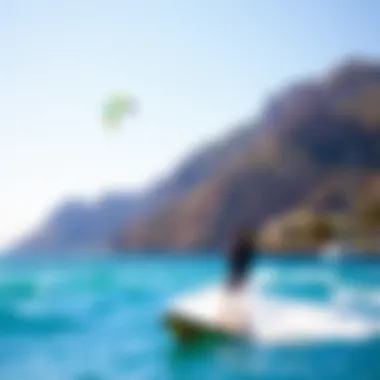
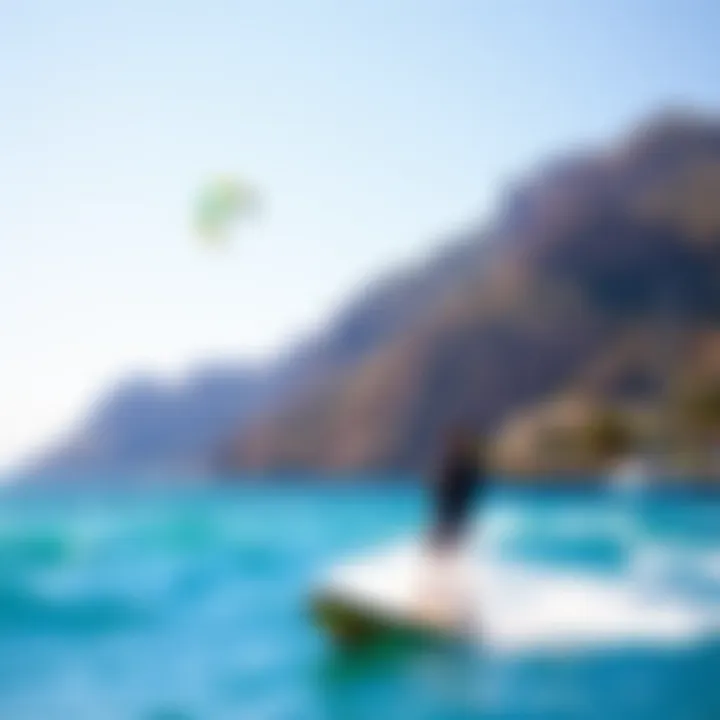
Top Locations Globally
When it comes to kitesurfing, some destinations have become household names among enthusiasts. Each of these spots offers unique attributes that cater to varying skill levels, ensuring that riders from beginners to experts find their sweet spot. Here are some of the hottest kitesurfing areas:
- Cabarete, Dominican Republic: Known for its consistent trade winds, Cabarete attracts kiteboarders year-round. The stunning beaches and lively local scene add to the allure of this Caribbean gem.
- Lagos, Portugal: With its picturesque cliffs and warm waters, Lagos is a favorite among many. The area boasts a variety of kite spots for different wind conditions, as well as a vibrant nightlife.
- Maui, Hawaii: Renowned for its breathtaking scenery, Maui offers superb spots such as Kanaha Beach. The trade winds combined with warm weather create ideal conditions nearly year-round.
- Tarifa, Spain: Often called the kitesurfing capital of Europe, Tarifa benefits from strong winds and a lively atmosphere, making it a premier location for those wanting to feel the thrill on the water.
- Bonaire, Caribbean: Recognized for its flat water and superb visibility, Bonaire is a paradise for freeriders and those looking to refine their skills. The calm turquoise waters entice kitesurfers of all levels.
Each of these spots not only showcases the beauty of nature but also fosters a sense of community. The presence of local shops, schools, and events makes it easy for any rider to integrate and learn.
Evaluating Destination Conditions
Before packing your bags and heading off to one of these paradises, it’s imperative to consider various factors that can influence your kitesurfing experience. Here are a few aspects worth pondering:
- Wind Patterns: Understanding the local wind seasonality is crucial. Not all places offer reliable winds all year round. Research the best time to visit your chosen destination to ensure you catch the right conditions.
- Water Conditions: Are you looking for flat water to practice freestyle skills, or do you prefer waves for a more exhilarating ride? Knowing what type of water conditions you’ll encounter helps in selecting the appropriate gear and planning your sessions.
- Local Regulations: Different spots have varying rules around kitesurfing. Always familiarize yourself with local guidelines to ensure that you’re not only enjoying yourself but also being a good steward of the environment. Check for any specific areas designated for kitesurfing versus zones that may be off-limits.
- Accessibility: The ease of getting to and from the water can greatly impact your experience. Assess the distance of accommodations from kite spots, as well as the availability of transportation.
- Community and Facilities: A thriving community can enhance your experience significantly. Look for locations that have rental shops, schools, and social events to connect with fellow enthusiasts.
"A great destination combines excellent kitesurfing conditions with a vibrant community, making it feel like home, no matter where you come from."
Taking the time to evaluate these conditions can mean the difference between a good time and a great time on the water. Dive deep into your chosen location's environment and make sure you are set for the ride of your life!
The Role of Community in Kitesurfing
Kitesurfing is more than just a sport; it’s a lifestyle that thrives on community. For those who love the adrenaline rush of gliding over waves, the experiences shared within the kitesurfing community can enrich the journey considerably. Whether one is a seasoned pro or just starting out, connecting with fellow riders can lead to lifelong friendships and deeper engagement with the sport.
Connecting with Other Riders
Engagement with other kitesurfers is vital for anyone wanting to truly embrace the kitesurfing culture. When you hit the beach, chances are you spot a group of enthusiasts ready to share tips, tricks, and their local knowledge. This sense of camaraderie fosters an environment where riders can learn and improve their skills collectively.
- Building Relationships: Meeting other kitesurfers on the beach or at a local spot creates a network of support. You can swap stories about gear, techniques, and wipeouts. Friends often help you push your limits, learn from one another, and even invite you to new spots.
- Skill Development: Practicing with others allows you to pick up new skills faster. Watching someone master a trick can motivate you to try it yourself and receive immediate feedback. You might not realize the small adjustments you need until a fellow rider points them out.
- Shared Resources: Sometimes, it’s not just about learning tricks; it’s about sharing the gear as well. Exploring new setups, trying out different boards, or even borrowing a kite can open up new avenues for personal development.
- Creating Events: Local communities often come together to organize events. These gatherings foster not only competition but also genuine friendship and collaboration among participants.
Participation in Events and Competitions
Events and competitions play a critical role in enhancing one’s kitesurfing experience and building a robust community. They are not just about winning; they’re about coming together as a community, celebrating the sport, and inspiring each other.
- Exposure to New Styles: When you attend different competitions, you get a chance to see varied styles of kitesurfing. Diverse conditions and gear setups suggest new strategies for your riding. This exposure can be a game-changer for your own approach to the sport.
- Networking Opportunities: Competitions attract not only riders but also sponsors and companies. Networking can open doors for endorsements and great deals on gear. You might meet someone who offers to sponsor your next adventure, or invites you to ride in a different location.
- Encouraging Participation: Grassroots events give beginners a chance to step onto a platform, perhaps for their first time. This encouragement is essential in expanding the sport as it allows new riders to showcase their passion and to inspire others to join.
- Creating Lasting Memories: Whether it’s a competition or a local hangout, events create memories that last a lifetime. There’s something special about competing against friends, sharing meals after a long day on the water, or simply enjoying the atmosphere on the beach.
The community connects riders across generations and skill levels, and strengthens the culture that makes kitesurfing a unique and exhilarating experience. Embracing this community aspect not only enhances personal growth, but also preserves the spirit of the sport for future enthusiasts.
"Together we ride, together we grow."
For more insights on community-driven events and kitesurfing interactions, you can explore blogs and forums on Reddit or engage with communities on Facebook. Whether it’s sharing kite knowledge or launching group trips, the sport thrives on these collaborative efforts.
Latest Trends in Kitesurfing Equipment
As the world of kitesurfing continues to evolve, staying abreast of the latest trends in equipment is crucial for both new and seasoned riders. These trends not only enhance performance on the water but also influence the overall experience of the sport. Understanding what’s hot and what’s not can ensure that participants are fully equipped to tackle different conditions, push their limits, and refine their styles.
The arrival of lightweight materials coupled with better construction techniques means that today’s kites are more resilient and offer improved performance. Equipment is designed to withstand harsh conditions without sacrificing maneuverability or speed. Riders looking to maximize their fun should pay attention to breakthroughs in materials that focus on durability, efficiency, and versatility.
Innovative Materials
One of the most noticeable trends in kitesurfing equipment revolves around the use of innovative materials. Modern kites are often crafted from cutting-edge fabrics that enhance performance while also being environmentally conscious.
- Dyneema: Known for its strength-to-weight ratio, Dyneema is increasingly used in the construction of lines and bridles, providing excellent durability during extreme conditions. Kite manufacturers are now recognizing its potential to improve reliability and safety on the water.
- Recycled Fabrics: In light of the growing concern for the environment, various brands are turning to recycled materials for creating their kites and boards. This not only minimizes waste but also paves the way for a sustainable kitesurfing experience. Supporting brands with eco-friendly innovations plays a part in promoting responsible practices within the sport.
These materials not only prolong the lifespan of equipment but also contribute to lighter designs that can have a significant impact on kitesurfing performance. Riders can experience enhanced responsiveness, better control, and overall ease of use, translating into a more enjoyable time on the water.
Technological Advancements
Another major trend centers around technological advancements that are transforming how kitesurfers approach the sport. Advances in technology continue to enhance the interaction between riders and their gear, leading to a dynamic, intuitive riding experience.
- Smart Kites: Manufacturers are introducing kites equipped with sensors and GPS tracking, providing real-time data on wind conditions and rider performance. This information can help in making informed decisions mid-ride, maximizing both safety and enjoyment.
- Performance Analytics: Devices that analyze technique and performance are becoming popular among kiteboarders keen to improve their skills. From analyzing jumps to measuring speed, such tools offer insights that allow for targeted improvements.
- Safety Features: Improved safety systems focus on quick responsiveness and easy deployment. For example, integrated quick-release systems in harnesses and leashes are now designed to minimize risks. Riders can easily detach from their equipment in emergencies, safeguarding against potential accidents.
The amalgamation of innovative materials and technological advancements not only enhances performance but also leads to better safety protocols in kitesurfing. As these trends take root, they provide riders with enhanced experiences and greater connection to the sport.
"Staying informed about the latest trends in kitesurfing equipment is essential for maximizing both safety and performance."
Kitesurfers, whether just starting out or competing, stand to gain significantly from embracing these innovations. Transitioning to new equipment can markedly improve one’s riding experience, making it essential to adapt and evolve with the sport.
Personalizing Your Kitesurfing Experience
Personalizing your kitesurfing experience can be the key to unlocking your true potential on the water. While many riders start with standard setups, customizing gear and adjusting techniques to align with personal preferences can dramatically enhance performance and enjoyment. Understanding the nuances of tailoring your experience will not just make it more enjoyable; it can also improve safety and efficiency. Each kiteboarder brings their own flair and style, and personalizing one’s approach promotes that individuality.
Customizing Gear for Performance
When it comes to kitesurfing, one size definitely does not fit all. Each rider has unique physical characteristics, skills, and preferences that dictate their ideal setup. Here’s why customizing gear is paramount:
- Kite Size and Shape: Depending on your weight, skill level, and local wind conditions, you might lean toward a larger kite for more lift or a smaller one for faster turns. Duotone offers various styles, residential options, and features to suit different riding styles.
- Board Selection: The board’s size, shape, and flex can make a world of difference. A stiffer board is better for speed while softer ones are great for tricks. Riders should choose one that complements their technique and riding environment.
- Harness Considerations: Comfort is crucial when you’re out on the water for hours. Various styles, such as seat or waist harnesses, can affect your performance. Test out different types to see what feels best.
"Customizing your gear isn't just about performance—it's about making every ride your own."
Beyond adjustments, integrating quality materials into gear can create significant advantages. Riding with lighter equipment or the latest technological advancements can really change your experience on the water. Familiarizing yourself with gear options can be the difference between a decent day on the waves and an extraordinary one.
Choosing Your Style of Riding
Just as no two riders are the same, no two kitesurfing styles are identical. Whether you prefer stunning aerial tricks or smooth cruising, finding a style that resonates with you is vital. Here are a few common styles to consider:
- Freestyle: Focuses on tricks and aerial maneuvers. Ideal for riders who enjoy showcasing skills and pushing their limits.
- Wave Riding: This style involves riding on ocean waves, enhancing your connection with nature. It's about mastering the elements and feeling the rhythm of the water.
- Freeride: A hybrid style that suits those who enjoy a bit of everything, from carving up the water to catching big air. Perfect for leisurely outings as well.
Investing time into discovering what suits you can lead to a much more gratifying experience overall. You might switch from one style to the other based on conditions or your mood, so being open to adaptations can further enrich your experience.
In summary, personalizing your kitesurfing experience encompasses both gear adjustments and awareness of riding styles. Engaging with this aspect will undoubtedly contribute to a deeper enjoyment of the sport. By being intentional about personal touches, riders not only excel in performance but also foster a greater passion for kitesurfing as a whole.















